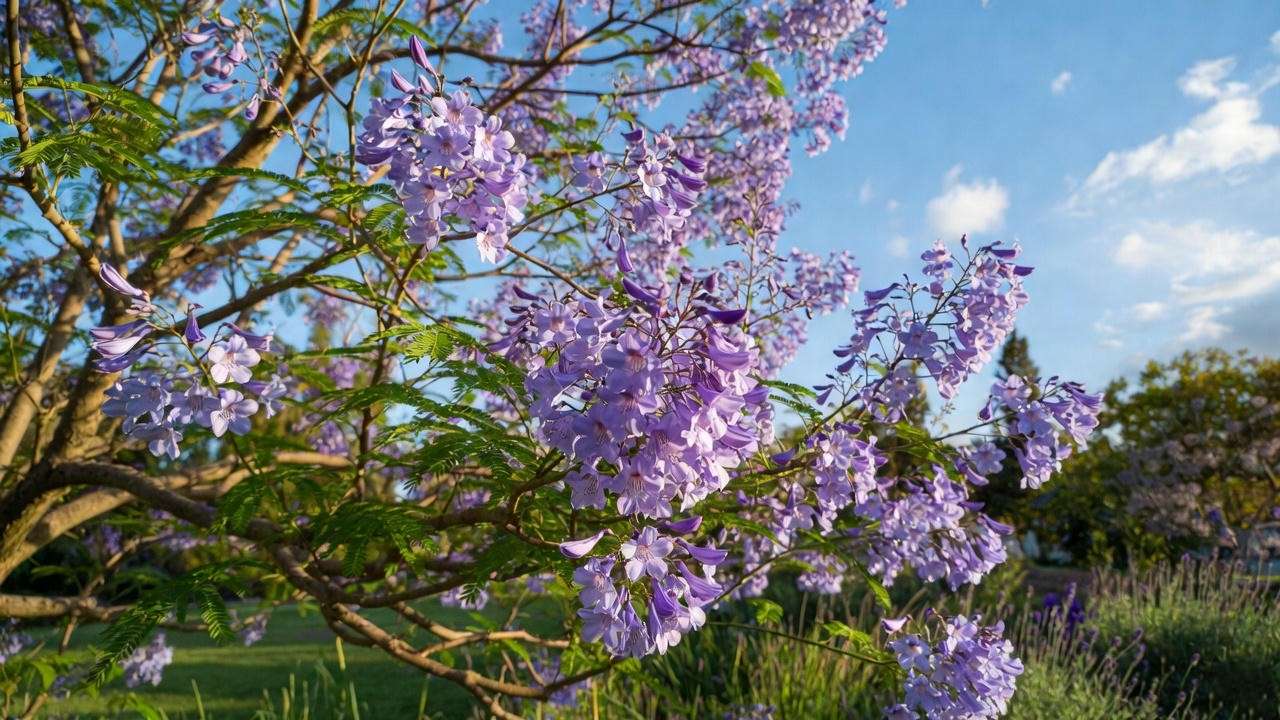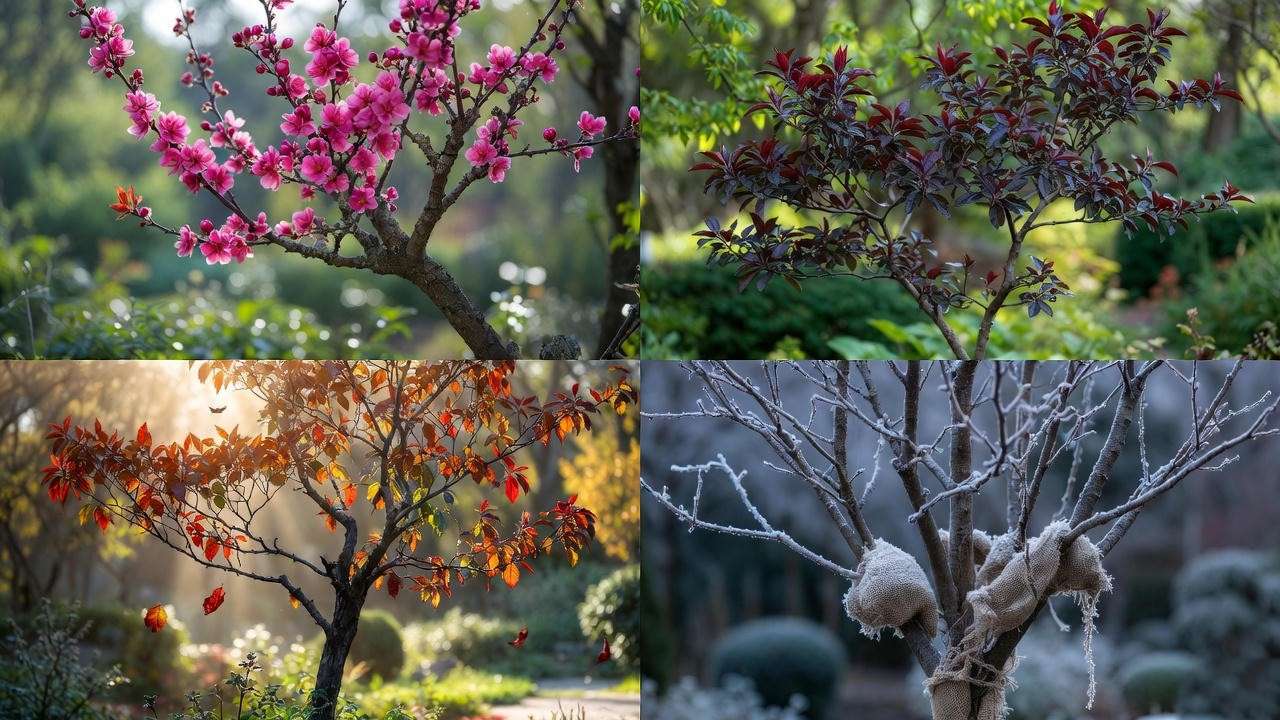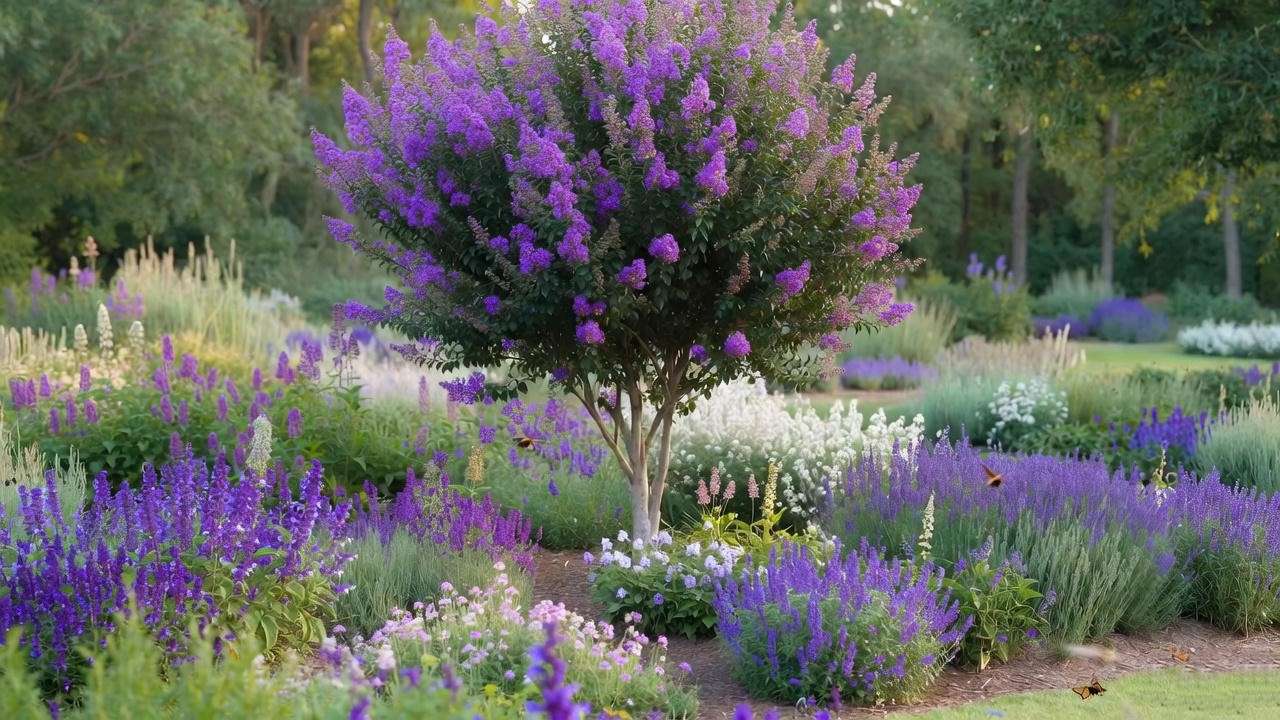Imagine stepping into your garden and being greeted by a cascade of vibrant purple blooms swaying gently in the breeze—a purple blossom tree in full splendor. These breathtaking trees, from the ethereal Jacaranda to the hardy Purple Leaf Plum, are more than just eye candy; they’re a statement of beauty and resilience. Whether you’re a seasoned gardener or a beginner, caring for a purple blossom tree can transform your outdoor space into a vibrant oasis. But how do you ensure these trees thrive year-round? In this comprehensive guide, I’ll share seven expert tips to keep your purple blossom tree healthy, vibrant, and blooming spectacularly. Backed by decades of horticultural expertise and hands-on experience, this article will empower you to overcome common challenges and nurture your tree with confidence. Let’s dive in and unlock the secrets to a thriving purple blossom tree! 🌟
H2: Understanding the Purple Blossom Tree: A Vibrant Garden Star 🌟
H3: What Makes Purple Blossom Trees Special?
Purple blossom trees are nature’s showstoppers, blending stunning aesthetics with ecological benefits. Popular species like Jacaranda mimosifolia, with its lavender-blue blooms, Prunus cerasifera (Purple Leaf Plum), known for its rich foliage, and Lagerstroemia indica (Crape Myrtle), prized for its long-lasting flowers, bring unparalleled charm to gardens. These trees vary in size, from compact dwarfs for small yards to towering giants for expansive landscapes. Beyond their beauty, they attract pollinators like bees and butterflies, enhance air quality, and provide cooling shade. Most thrive in USDA hardiness zones 7-10, preferring well-draining soil and full sun exposure.

H3: Challenges of Growing Purple Blossom Trees
Despite their allure, purple blossom trees face challenges like pests (aphids, scale), diseases (powdery mildew, root rot), and environmental stressors (drought, frost). Improper care—such as overwatering or incorrect pruning—can lead to sparse blooms or stunted growth. “Tailored care is key to unlocking a purple blossom tree’s full potential,” says Dr. Emily Carter, a certified arborist with 20 years of experience. This article addresses these challenges with practical, science-backed solutions to ensure your tree flourishes.
H2: Tip 1: Choosing the Right Purple Blossom Tree for Your Climate 🌍
Selecting the right purple blossom tree for your climate is the foundation of successful care. Different species have unique needs:
- Jacaranda mimosifolia: Thrives in warm, frost-free climates (USDA zones 9-11). Ideal for coastal or tropical regions.
- Prunus cerasifera (Purple Leaf Plum): Adapts to cooler climates (zones 5-8), tolerating light frosts.
- Lagerstroemia indica (Crape Myrtle): Versatile for zones 7-9, with excellent drought tolerance.
Comparison Table: Popular Purple Blossom Trees
| Species | Hardiness Zones | Bloom Season | Mature Height | Key Features |
| Jacaranda mimosifolia | 9-11 | Spring-Summer | 25-50 ft | Lavender-blue blooms, fern-like leaves |
| Prunus cerasifera | 5-8 | Early Spring | 15-25 ft | Purple foliage, pink blossoms |
| Lagerstroemia indica | 7-9 | Summer-Fall | 10-30 ft | Long-lasting blooms, vibrant colors |
Before planting, assess your local climate, soil type, and sunlight availability. For example, a homeowner in USDA Zone 9 successfully grew a Crape Myrtle by choosing a sunny, well-drained spot, avoiding the heavy clay soils that can stunt growth. Consult your local cooperative extension for soil testing to ensure compatibility.
H2: Tip 2: Planting Your Purple Blossom Tree for Success 🌱
Proper planting sets the stage for a healthy purple blossom tree. Follow these steps:
- Choose the Right Site: Select a location with full sun (6+ hours daily) and well-draining soil. Avoid low-lying areas prone to waterlogging.
- Prepare the Soil: Test soil pH (ideal range: 6.0-7.0) and amend with organic compost to improve fertility and drainage.
- Dig the Hole: Make it twice as wide and as deep as the root ball. Loosen the soil to encourage root growth.
- Plant Carefully: Place the tree at the same depth as it was in its nursery pot. Backfill with soil, tamp gently, and water thoroughly.
Common Mistakes to Avoid:
- Planting too deep, which suffocates roots.
- Ignoring soil pH, leading to nutrient deficiencies.
- Overcrowding with other plants, restricting growth.
Pro Tip: Add a 2-3 inch layer of organic mulch (e.g., wood chips) around the base to retain moisture and regulate soil temperature, keeping it 2 inches from the trunk to prevent rot.

H2: Tip 3: Watering Wisely to Promote Healthy Growth 💧
Watering is critical for purple blossom trees, especially during their first few years. Here’s how to get it right:
- Newly Planted Trees: Water deeply (1-2 inches) every 5-7 days for the first year, ensuring the root zone is saturated.
- Established Trees: Water every 10-14 days during dry spells, focusing on deep irrigation to encourage strong roots.
- Seasonal Adjustments: Increase watering in summer to combat heat stress; reduce in winter when trees are dormant.
Signs of Watering Issues:
- Overwatering: Yellowing leaves, soggy soil, or root rot.
- Underwatering: Wilting, dry leaves, or stunted growth.
A 2023 study by the University of Florida Extension recommends deep, infrequent watering to mimic natural rainfall, promoting resilience. Use a soaker hose or drip irrigation for efficiency. Monitor soil moisture with a simple finger test: if the top 2 inches are dry, it’s time to water.
H2: Tip 4: Pruning for Vibrant Blooms and Strong Structure ✂️
Pruning enhances blooms and maintains a healthy structure. Here’s a species-specific guide:
- Jacaranda: Lightly prune in late winter to remove dead or crossing branches. Avoid heavy cuts to preserve its open canopy.
- Purple Leaf Plum: Prune in early spring to shape and remove suckers. Thin crowded branches to improve air circulation.
- Crape Myrtle: Prune in late winter to encourage summer blooms. Avoid “crape murder” (severe topping), which weakens the tree.
Pruning Steps:
- Use clean, sharp pruning shears sanitized with rubbing alcohol.
- Remove dead, damaged, or diseased branches first.
- Thin crowded areas to improve light and air penetration.
- Shape for aesthetics, maintaining the tree’s natural form.
Visual Aid: [Link to a pruning diagram or video for clarity, e.g., from a university extension site.]
Common Mistake: Over-pruning, which stresses the tree and reduces blooms. Always prune conservatively, removing no more than 20% of the canopy annually.

H2: Tip 5: Fertilizing for Lush Foliage and Blooms 🌿
Fertilizing fuels vibrant blooms and healthy foliage. Use a balanced fertilizer (e.g., 10-10-10 NPK) or a slow-release formula designed for flowering trees.
- Timing: Apply in early spring as growth begins. A second application in mid-summer can boost blooms for Crape Myrtles.
- Application: Spread granular fertilizer evenly around the drip line (the area under the canopy’s edge), then water thoroughly.
- Organic Options: Compost, well-rotted manure, or fish emulsion for eco-conscious gardeners.
Signs of Nutrient Deficiency:
- Pale or yellowing leaves: Nitrogen deficiency.
- Poor flowering: Phosphorus shortage.
- Weak growth: Potassium imbalance.
A soil test (available through local cooperative extensions) pinpoints nutrient needs. For example, a gardener in Texas revived a struggling Jacaranda by correcting a nitrogen deficiency identified through testing.
Pro Tip: Avoid over-fertilizing, which can burn roots or cause excessive leafy growth at the expense of blooms.
H2: Tip 6: Protecting Your Purple Blossom Tree from Pests and Diseases 🐞
Purple blossom trees, while resilient, can fall prey to pests and diseases if not properly monitored. Proactive care is essential to keep your tree healthy and vibrant. Here’s how to protect your tree:
H3: Common Pests
- Aphids: Tiny sap-sucking insects that cause curled leaves and sticky residue. They’re common on Crape Myrtles and Purple Leaf Plums.
- Scale Insects: Small, immobile pests that form hard shells on branches, weakening the tree.
- Spider Mites: Microscopic pests causing stippled leaves, especially in hot, dry conditions.
H3: Common Diseases
- Powdery Mildew: A white, powdery coating on leaves, often affecting Jacarandas in humid climates.
- Root Rot: Caused by overwatering or poor drainage, leading to wilting and decay.
- Leaf Spot: Dark spots on leaves, typically fungal, seen in Purple Leaf Plums during wet seasons.
H3: Prevention Strategies
- Regular Inspections: Check leaves, stems, and soil monthly for signs of pests or disease.
- Proper Spacing: Plant trees with enough room for air circulation to reduce fungal risks.
- Sanitation: Remove fallen leaves and debris to prevent pest breeding grounds.
- Healthy Practices: Maintain proper watering and fertilization to boost tree resilience.
H3: Treatment Options
- Organic Remedies: Use neem oil or insecticidal soap for aphids and spider mites. For powdery mildew, apply a baking soda solution (1 tbsp per gallon of water).
- Chemical Controls: Use targeted pesticides only as a last resort, following local regulations and arborist advice.
- Professional Help: For severe infestations or diseases, consult a certified arborist. For example, a gardener in California successfully managed aphid infestations on a Purple Leaf Plum by applying neem oil weekly and improving irrigation practices.
Expert Insight: According to a 2024 study by the University of Georgia Extension, integrated pest management (IPM) combining cultural practices and organic treatments is 80% effective in controlling common tree pests without harming beneficial insects like pollinators.
H2: Tip 7: Seasonal Care to Ensure Year-Round Beauty 🍂
Purple blossom trees require tailored care throughout the year to maintain their health and beauty. Here’s a seasonal breakdown:
H3: Spring 🌸
- Fertilize: Apply a balanced fertilizer to kickstart growth.
- Prune: Shape trees and remove winter damage before new growth begins.
- Monitor Pests: Check for early signs of aphids or spider mites as temperatures rise.
H3: Summer ☀️
- Water Consistently: Deep water during heatwaves to prevent drought stress.
- Mulch: Refresh a 2-3 inch layer of organic mulch to retain moisture and keep roots cool.
- Inspect for Stress: Look for wilting or scorched leaves, adjusting care as needed.
H3: Fall 🍁
- Prepare for Dormancy: Reduce watering as growth slows.
- Clean Up: Rake fallen leaves to prevent fungal diseases like leaf spot.
- Soil Testing: Conduct a fall soil test to plan spring fertilization.
H3: Winter ❄️
- Protect Young Trees: Wrap trunks with burlap or use frost cloths in colder climates (e.g., zones 5-7 for Purple Leaf Plums).
- Minimize Watering: Water sparingly, only during prolonged dry spells.
- Inspect Structure: Check for storm damage or weak branches to prune in late winter.
Seasonal Care Checklist:
- Spring: Fertilize, prune, inspect for pests.
- Summer: Water deeply, mulch, monitor for heat stress.
- Fall: Reduce watering, clean debris, test soil.
- Winter: Protect from frost, limit watering, inspect for damage.
This seasonal approach ensures your purple blossom tree remains vibrant and healthy year-round.

H2: Troubleshooting Common Purple Blossom Tree Problems ⚠️
Even with diligent care, issues can arise. Below is a troubleshooting guide for common concerns:
Table: Common Issues, Symptoms, Causes, and Solutions
| Issue | Symptoms | Causes | Solutions |
| Lack of Blooms | Few or no flowers | Improper pruning, nutrient deficiency | Prune correctly, fertilize with phosphorus-rich formula |
| Yellowing Leaves | Leaves turn yellow, drop | Overwatering, nutrient issues | Adjust watering, test soil for deficiencies |
| Wilting or Drooping | Limp leaves, droopy branches | Underwatering, root rot | Deep water, improve drainage |
| Leaf Spots | Dark spots on leaves | Fungal infection | Apply fungicide, improve air circulation |
Reader Engagement: Have a specific issue with your purple blossom tree? Share it in the comments below, and our expert team will offer tailored advice!
For example, a gardener in Florida noticed their Jacaranda wasn’t blooming. After consulting an arborist, they discovered over-pruning was the culprit. By adjusting their pruning schedule and adding a phosphorus-heavy fertilizer, blooms returned the following season.
H2: Enhancing Your Garden with Purple Blossom Trees 🎨
Purple blossom trees can elevate your garden’s aesthetic and ecological value. Here’s how to maximize their impact:
- Companion Planting: Pair with plants like lavender, salvia, or daylilies to complement purple blooms and attract pollinators. For example, planting lavender under a Crape Myrtle creates a stunning purple-themed border.
- Small vs. Large Gardens: Choose dwarf varieties (e.g., ‘Petite Plum’ Crape Myrtle) for patios or small yards, and larger species like Jacarandas for spacious landscapes.
- Environmental Benefits: These trees support bees, butterflies, and birds while improving air quality and providing shade.
- Design Inspiration: A homeowner in Arizona transformed their backyard with a Jacaranda centerpiece, surrounded by native wildflowers, creating a vibrant, low-maintenance oasis.
Visual Idea: Include high-quality images of a purple blossom tree garden or a design sketch to inspire readers.

H2: Frequently Asked Questions (FAQs) ❓
Q: How long does it take for a purple blossom tree to bloom?
A: It varies by species. Crape Myrtles may bloom in 2-3 years, while Jacarandas take 5-7 years to reach full flowering potential.
Q: Can purple blossom trees grow in containers?
A: Yes, dwarf varieties like certain Crape Myrtles thrive in large pots with well-draining soil and full sun.
Q: What’s the best time to plant a purple blossom tree?
A: Early spring or fall, when temperatures are mild, promotes strong root establishment.
Q: How do I protect my tree from winter frost?
A: Use mulch, burlap wraps, or frost cloths for young trees in colder zones. Water sparingly to avoid root stress.
Q: Why are my tree’s leaves dropping early?
A: Early leaf drop can result from drought, pests, or disease. Check soil moisture, inspect for pests, and ensure proper fertilization.
H2: Conclusion: Your Path to a Thriving Purple Blossom Tree 🌸
Caring for a purple blossom tree is a rewarding journey that transforms your garden into a vibrant masterpiece. By following these seven essential tips—choosing the right species, planting correctly, watering wisely, pruning strategically, fertilizing appropriately, protecting against pests, and providing seasonal care—you’ll ensure your tree thrives year-round. Backed by horticultural expertise and real-world success stories, this guide equips you with everything needed to overcome challenges and nurture a healthy, blooming tree. Start implementing these tips today, and watch your purple blossom tree become the star of your landscape! Share this article with fellow gardeners, leave your questions in the comments, or explore our related guides on tree care for more inspiration. 🌳













